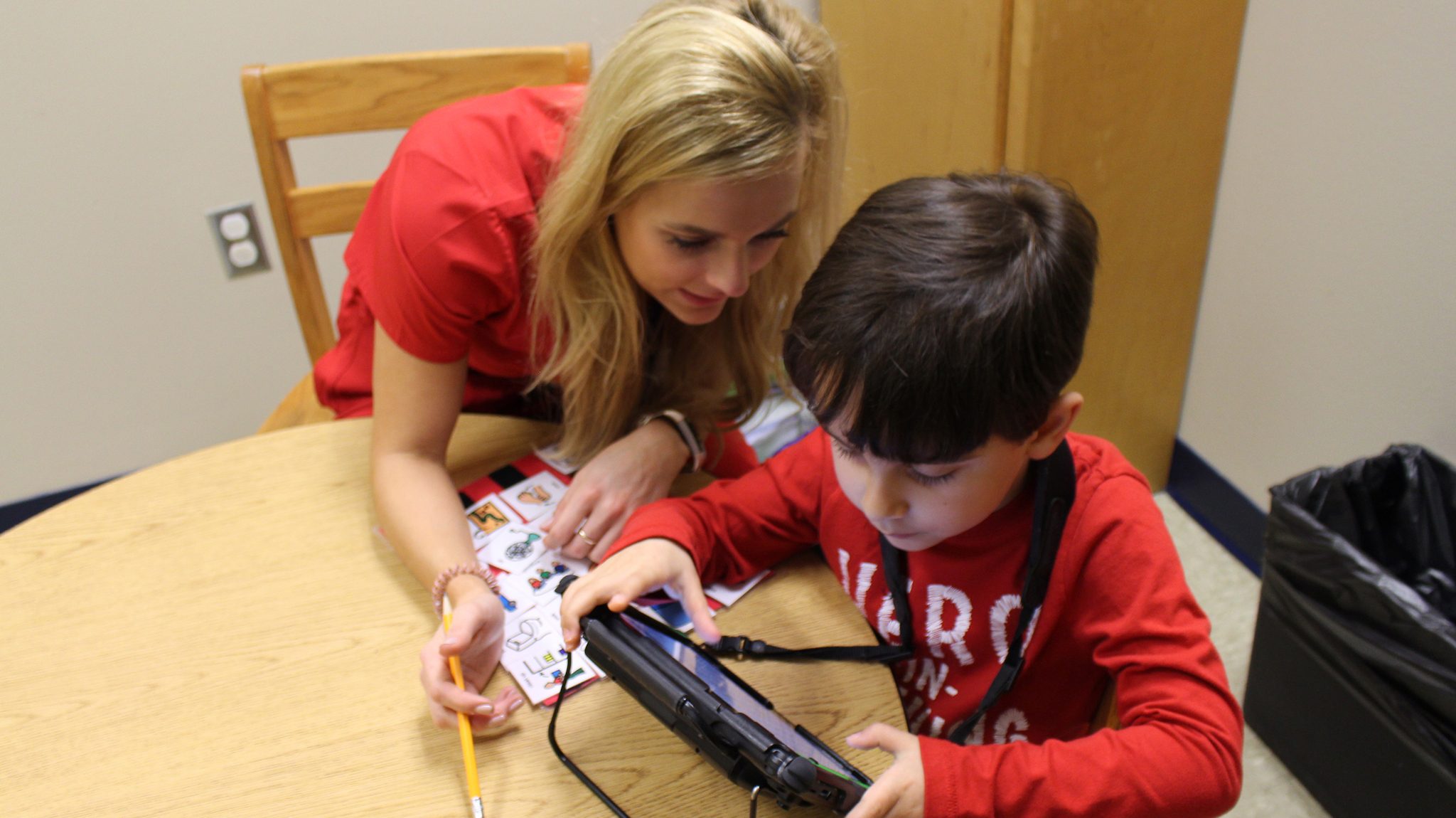
Courtney Walden, a UM graduate student in communication sciences and disorders, helps a young client navigate his augmentative communication device. Photo by Sarah Sapp/School of Applied Sciences
OXFORD, Miss – With 11 percent of children ages 3-6 having a speech, language, voice or swallowing disorder and almost 15 percent of school-age children experiencing some degree of hearing loss, communication disorders are among the most common disabilities in children nationwide.
During May, which is Better Hearing and Speech Month, Vishakha Rawool, chair of the Department of Communication Sciences and Disorders at University of Mississippi, urges families to learn the early signs of these disorders and seek an assessment if they have concerns.
“Communication disorders are treatable, yet all too often, we find parents are waiting longer than we’d like to bring their child in for an evaluation,” Rawool said. “Timely intervention is important, as untreated speech-language and hearing disorders can lead to problems with reading and writing, academic success, social interactions, behavioral problems and more.
“These disorders are highly treatable and, in some cases, can be reversed or even prevented. So our message to parents is: If you have any concern, don’t wait and see if there is a change. Trust your instincts and get it checked out.”
Hearing loss is evaluated and treated by audiologists. Speech and language disorders are evaluated and treated by speech-language pathologists. Warning signs of these disorders include:
Language Disorders
- Does not smile or interact with others (birth and older)
- Does not babble (4-7 months)
- Makes only a few sounds or gestures, such as pointing (7-12 months)
- Does not understand what others say (7 months-2 years)
- Says only a few words (12-18 months)
- Words are not easily understood (18 months-2 years)
- Does not put words together to make sentences (1.5-3 years)
- Has trouble playing and talking with other children (2-3 years)
- Has trouble with early reading and writing skills (2.5-3 years)
Speech Sound Disorders
- Says “p,” “b,” “m,” “h” and “w” incorrectly in words (1-2 years)
- Says “k,” “g,” “f,” “t,” “d” and “n” incorrectly in words (2-3 years)
- Produces speech that is unclear, even to familiar people (2-3 years)
Stuttering
- Repeats first sounds of words: “b-b-b-ball” for “ball”
- Speech breaks while trying to say a word: “—–boy” for “boy”
- Stretches sounds out: “ffffff-farm” for “farm”
- Shows frustration when trying to get words out
Voice Disorders
- Uses a hoarse or breathy voice
- Uses a nasal-sounding voice
Hearing Loss
- Shows a lack of attention to sounds (birth-1 year)
- Does not respond when you call their name (7 months-1 year)
- Does not follow simple directions (1-2 years)
- Shows delays in speech and language development (birth-3 years)
- Pulls or scratches at their ears
- Has difficulty achieving academically, especially in reading and math
- Is socially isolated and unhappy at school
- Has persistent ear discomfort after exposure to loud noise, including regular and constant listening to electronics at high volumes
Families can learn more about these signs, get tips for helping their child and find a searchable database of professionals who treat communication disorders at http://IdentifytheSigns.org. People who want to schedule an assessment may contact the UM Speech and Hearing Clinic at 662-915-7271 or by email at umcdshc@olemiss.edu.
The School of Applied Sciences, home of the Department of Communication Sciences and Disorders, offers professional preparation programs that integrate academic study, clinical training, creative research, service-learning and community outreach, leading to the development of leaders whose professional endeavors will improve health and well-being.